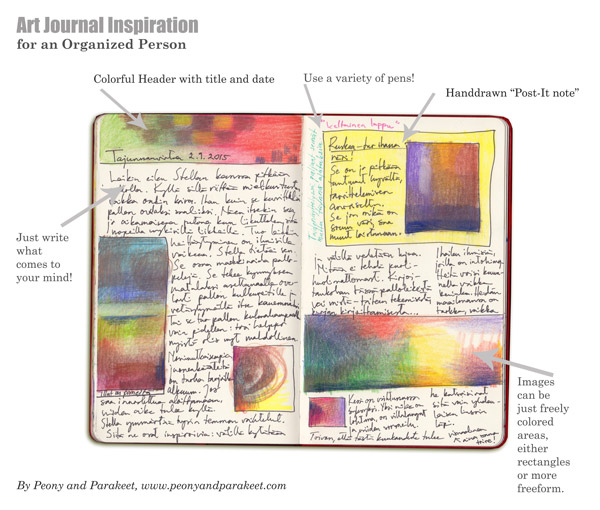Joyful Flowers with Watercolor Pencils – Watch the Video!
This week, I have a free video where I create these joyful flowers with watercolor pencils. These are inspired by fabric prints and are more motif-like than many of my colored pencil pieces. I love this kind of playing with style.

This is a small piece, just 8 x 8 inches. It’s colored freely with watercolor pencils on thick drawing paper.
Joyful Flowers – Watch the Video!
In the video, I talk about finding inspiration for art-making and tell stories about things that have affected my style. I just read abstract painter Darby Bannard‘s quote:
“Inspiration doesn’t follow style, it creates it.”
It made me want to share my thoughts about inspiration and style. I also wanted to create something colorful and cheerful that is not realistic, but more design-oriented. These joyful flowers were fun to make. After drawing the joyful flowers, I made something small to add to my boxes of joy. You can see that little flowery thing in the video too. Watch the video!
This video is a little longer than I usually post, but I personally like to watch long videos, and maybe you do too?
Joyful Coloring
My newest course Joyful Coloring teaches a color-oriented approach to watercolor pencils.

Start with blank paper and create freely with joy and sunshine! >> Buy here!
Painting by Programming – Modern Vanitas
Happy Halloween! This year’s Halloween artwork combines painting and programming.

This week, I have a video that has excerpts from the artwork I programmed. The program picks four of my paintings at a time and forms a Vanitas-type arrangement with a skull, fallen crown, extinguished candles, and withering flowers – symbols of our transience. The program has 50 paintings from 2021-2024 to choose from. The music for the video is composed by me, representing a conversation about the temporary nature of life.
You can watch the video bigger by pressing the last icon on the menubar.
If you are interested in seeing more of this artwork, here’s a longer video that explains the Vanitas concept and shows more samples.
I designed the 3-dimensional shapes and then blended the paintings on them by programming.
Painting by Programming
One of my oil paintings is also Vanitas, so the theme is very familiar to me. The transience of life has both horror and beauty, maybe emptiness too that goes well with the machines. The way the computer paints with me produces fascinating details.




We can continue the tradition of Vanitas paintings and use any technique to make our own versions.
What kind of version would you create?
P.S. This month there was a digital art exhibition “Deform and re-form” on the screens of the Helsinki Central Library Oodi. The exhibition called “Deform and Re-Form” was organized by the Finnish National Gallery’s digital team. Oodi is a very popular big library building, with lots of visitors every day. It felt great to see my artwork “Queen of the Night” there.
Even if a part of this year’s art is digital and painted by programming, I still keep creating traditional art as well.
What to Create with Colored Pencils? – Watch the Video!
This week I have a short inspirational video for you. I wanted to make a video that I can share on Instagram, so this has different portions than my videos usually are. You can watch it bigger by pressing the last icon on the menubar below the video.
Most of these drawings are made with regular colored pencils (or crayons as some call them) and some with watercolor pencils. I love both.
Coloring Freely on Blank Paper – Simple Start!
I am an advocate for coloring freely – starting with blank paper, adding colors on top of each other, and getting excited about what comes up. This doesn’t have to be anything difficult. Here’s an old picture from 2015 that I still find inspiring. You can illustrate your journaling with freely colored boxes.

Children draw freely with colored pencils, but when they grow up and become “colored pencil artists” they need all kinds of references to get started. References are great for learning some techniques, but they don’t make anyone an artist. A big part of art is in our mind – how we open up and how we allow ourselves to break boundaries.
Growing Your Skills
My love for colored pencils is based on a promise that I have made for my inner child: I will color for you and help others to color for theirs. So even if I make oil paintings and media art too, colored pencils always have a special place in my heart.

So, welcome to my courses to improve your skills and expand your artistic thinking!
P.S. You can still sign up for Joyful Coloring!

Coming Up – Joyful Coloring!
It’s exciting to announce that a new online art course is coming up! Joyful Coloring will begin on Sept 16, 2024. This course is for watercolor pencils. It has many fun projects – I hope you will love it! >> See more!
The early-bird registration has opened. >> Sign up here!
The early-bird sale will end on August 18th, 2024, at midnight PDT.